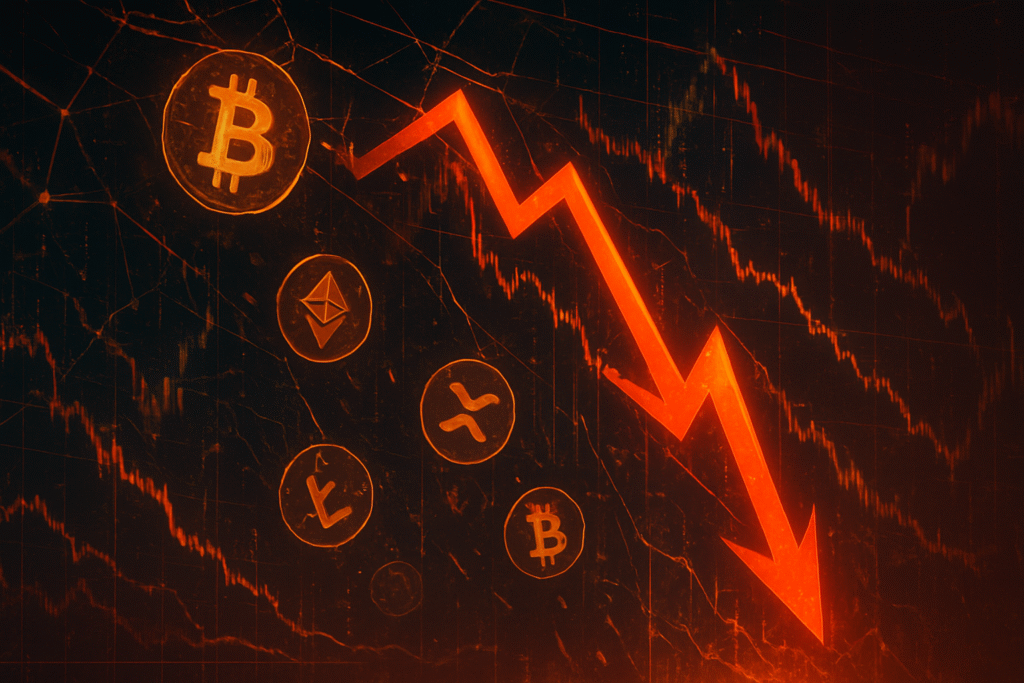
October 13, 2025 – The cryptocurrency market has been reeling from a staggering $131 billion crash that unfolded rapidly over October 10-11, 2025. This dramatic downturn, largely fueled by an unexpected announcement from former U.S. President Donald Trump regarding a 100% tariff on Chinese imports, sent shockwaves across the digital asset landscape. The news, signaling a severe escalation of global trade tensions, triggered an immediate and brutal sell-off, particularly decimating the altcoin sector and leading to one of the largest liquidation events in crypto history.
The fallout saw Bitcoin (BTC) plummet from its all-time high, while many altcoins experienced catastrophic declines of 70% to 90% in a matter of minutes. The crypto community reacted with a mixture of panic, disbelief, and calls for resilience, with nearly $9.6 billion in leveraged positions liquidated within a 24-hour period. This seismic event has not only underscored the inherent volatility of the crypto market but also highlighted the profound interconnectedness of digital assets with broader macroeconomic and geopolitical forces, forcing a critical re-evaluation of risk management and the structural integrity of the altcoin ecosystem.
Market Impact and Price Action
The market's reaction to the tariff announcement was swift and brutal. Bitcoin (BTC), often seen as a bellwether for the broader crypto market, experienced a significant downturn, plummeting approximately 13% from its then all-time high of $126,000. It briefly dipped below $107,000, even touching $102,000 at its nadir, before showing signs of stabilization. However, the brunt of the crash was borne by the altcoin market. Cryptocurrencies other than Bitcoin and Ethereum (ETH) saw their values evaporate at an alarming rate, with many suffering catastrophic declines ranging from 70% to an astonishing 90% in a mere matter of minutes. This "Altcoin Armageddon" highlighted the precarious nature of these assets, often characterized by thinner liquidity and a greater reliance on speculative trading and hype.
The sheer velocity of the market collapse triggered one of the largest single-day liquidation events in cryptocurrency history. Within a single hour, nearly $7 billion was wiped from leveraged positions across various exchanges, escalating to almost $9.6 billion in liquidations over a 24-hour period. These massive forced sales exacerbated the downward pressure, creating a cascading effect as margin calls were unmet. The rapid unwinding of highly leveraged positions primarily affected retail traders and speculative investors, many of whom were caught off guard by the sudden shift in market sentiment.
Comparatively, while the crypto market has weathered numerous storms—from the COVID-19 induced crash in March 2020 to the implosions of Terra/Luna and FTX in 2022—the October 2025 event distinguished itself by the sheer scale and speed of its liquidations. The market capitalization drop, with $131 billion attributed solely to altcoins, underscores the vulnerability of this segment. Technical analysts noted the breach of several key support levels for major altcoins, indicating a significant shift in market structure and potentially signaling a prolonged period of consolidation or further downside pressure as investors re-evaluate their risk exposure in a more volatile macroeconomic climate.
Community and Ecosystem Response
The immediate aftermath of the crash saw a torrent of activity across social media platforms, particularly Crypto Twitter and Reddit. Sentiment was a volatile mix of panic, frustration, and a desperate search for answers. Many traders, especially those who had employed high leverage, shared stories of devastating losses and widespread liquidations, fueling a collective sense of unease. Discussions on platforms like Reddit ranged from attributing the crash directly to Trump's tariff announcement to more elaborate theories involving "institutional power structures" and market manipulation. There was also a strong contingent arguing that over-leveraged positions were the primary culprit, regardless of the initial trigger.
Amidst the chaos, several crypto influencers and thought leaders emerged to offer guidance and perspective. A notable theme was the renewed advocacy for decentralization. Many highlighted the performance of decentralized exchanges (DEXs), which reportedly "kept on chugging" without major malfunctions, in stark contrast to potential slowdowns or issues on centralized exchanges (CEXs) during periods of extreme volatility. This served as a powerful testament to the resilience and stability offered by decentralized finance (DeFi), leading to renewed calls for investors to move assets to non-custodial wallets and embrace truly decentralized protocols.
While panic was palpable, a resilient faction within the community echoed the long-standing crypto mantra of "not panic selling." These voices encouraged holding long-term positions, viewing the crash as a potential buying opportunity—a familiar narrative from previous market downturns such as the COVID crash or the FTX collapse. However, a segment of external observers and even some within the crypto sphere expressed a degree of skepticism and schadenfreude, pointing to the inherent volatility and speculative risks that continue to characterize the digital asset space. The impact on specific NFT projects and other Web3 applications was less immediately clear, but the broader market downturn undoubtedly cast a shadow, likely affecting trading volumes and investor confidence in these nascent sectors.
What's Next for Crypto
The reverberations of the October 2025 crash are expected to shape the cryptocurrency market's trajectory in both the short and long term. In the immediate aftermath, severe price volatility, continued panic selling, and a persistent liquidity dry-up are anticipated. Investor sentiment, while showing early signs of a rebound for some assets, remains fragile, with fear, uncertainty, and doubt (FUD) still prevalent. However, many analysts view this deleveraging event as a necessary "leverage reset" or "technical correction" that, by flushing out excessive risk, could pave the way for a healthier, more sustainable market uptrend.
Longer-term implications point towards a significant maturation of the crypto ecosystem. The crash could accelerate a "flight to quality," reinforcing the foundational roles of Bitcoin and Ethereum while potentially weeding out less robust, highly speculative altcoins. This period is also expected to bolster institutional adoption, with continued inflows into Bitcoin and Ethereum Exchange-Traded Funds (ETFs) serving as a crucial indicator of confidence. The focus for projects will likely shift from speculative hype to strong fundamentals, real-world utility, and active development in areas like Decentralized Finance (DeFi) and smart contracts, reinventing traditional banking by reducing intermediaries. Furthermore, continuous technological advancements in blockchain, including Layer 1 and Layer 2 solutions for scalability and security, along with emerging applications like Decentralized Autonomous Organizations (DAOs), non-fungible tokens (NFTs), and AI integration, are poised to drive future growth.
Several potential catalysts could influence the market's recovery. Easing geopolitical tensions, particularly the trade dispute between the US and China, could provide a bullish impetus. Monetary policy decisions, especially interest rate cuts by the Federal Reserve (NASDAQ: FED), are anticipated to boost riskier assets. Regulatory clarity, such as the EU's MiCA Regulation and potential US legislation, could enhance legitimacy and attract further mainstream adoption, though over-regulation remains a concern. For projects, strategic considerations include prioritizing strong fundamentals, fostering robust community engagement, ensuring sustainable financial models, adapting to evolving regulatory landscapes, and relentlessly innovating. Investors, on the other hand, are advised to adopt disciplined risk management strategies like dollar-cost averaging (DCA), diversifying portfolios, conducting thorough fundamental analysis, monitoring macroeconomic indicators, and cultivating emotional resilience to navigate the choppy waters ahead.
Looking forward, three primary scenarios appear most likely. A quick V-shaped recovery (moderate likelihood) is plausible, driven by a "buy the dip" mentality and renewed institutional interest, with some analysts predicting Bitcoin could reach $130,000 by month-end or even $150,000-$200,000 by mid-2025, buoyed by halving cycles and ETF approvals. Alternatively, a prolonged consolidation or slower recovery (moderate likelihood) could unfold, especially if macroeconomic headwinds, persistent regulatory uncertainty, or geopolitical tensions persist. Finally, a market maturation and divergent performance (high likelihood) scenario suggests that well-established cryptocurrencies like Bitcoin and Ethereum will demonstrate greater resilience and recover more quickly, while highly speculative altcoins might struggle, leading to a "flight to quality" within the crypto space and a more stable, albeit perhaps less exuberant, ecosystem in the long run.
Bottom Line
The $131 billion crypto crash of October 2025 serves as a stark reminder of the inherent volatility within the digital asset markets. For crypto investors and enthusiasts, the key takeaways are profound: volatility is not an anomaly but a fundamental characteristic, demanding robust risk management strategies such as diversification, judicious use of stop-loss orders, and a strict adherence to only investing what one can afford to lose. The event underscored the dangers of over-leveraging and reinforced the value of a long-term perspective—often encapsulated by the "HODL" mantra—as short-term panic selling often locks in losses. Furthermore, the crash emphasized the critical importance of due diligence in selecting projects with strong fundamentals and the paramount need for asset security, advocating for self-custody in secure wallets.
In the long term, this market correction is likely to be viewed as a significant step in the market's maturation and resilience. Such downturns, while painful, act as a cleansing mechanism, purging unsustainable speculative activity and allowing projects with genuine utility and strong development to stand out. It will undoubtedly lead to increased regulatory scrutiny, which, despite potential short-term friction, can ultimately foster greater institutional adoption and provide much-needed consumer protection. This period of consolidation is also expected to drive innovation as projects focus on building real-world solutions and investor education as participants gain a deeper understanding of market dynamics and risk.
Regarding crypto adoption, the crash presents a complex picture. In the short term, it may cause hesitation among new retail investors wary of price swings. However, for institutional investors with longer horizons and greater risk tolerance, such downturns can represent strategic buying opportunities, especially as regulatory clarity potentially increases. Ultimately, sustained crypto adoption will hinge not on speculative fervor but on practical utility, ease of use, regulatory certainty, robust security, and scalability. The continued development of underlying infrastructure, regardless of price action, remains crucial.
Moving forward, investors and enthusiasts should closely monitor several critical metrics and developments. Macroeconomic indicators such as inflation rates, interest rate decisions by central banks like the Federal Reserve (NASDAQ: FED), and global economic stability will continue to exert significant influence. On-chain metrics like active addresses, transaction volume, and developer activity will provide insights into network health and adoption. Market structure metrics, including total market capitalization, Bitcoin dominance, and stablecoin market cap, will signal shifts in investor sentiment. Crucially, regulatory developments—new laws, guidance from financial authorities, and progress on Central Bank Digital Currencies (CBDCs)—will shape the operating environment. Finally, technological advancements in DeFi, Layer 1 and Layer 2 solutions, and institutional adoption (e.g., ETF approvals, corporate treasury allocations) will be key indicators of the market's long-term health and growth trajectory.
This article is for informational purposes only and does not constitute financial or investment advice. Cryptocurrency investments carry significant risk.





